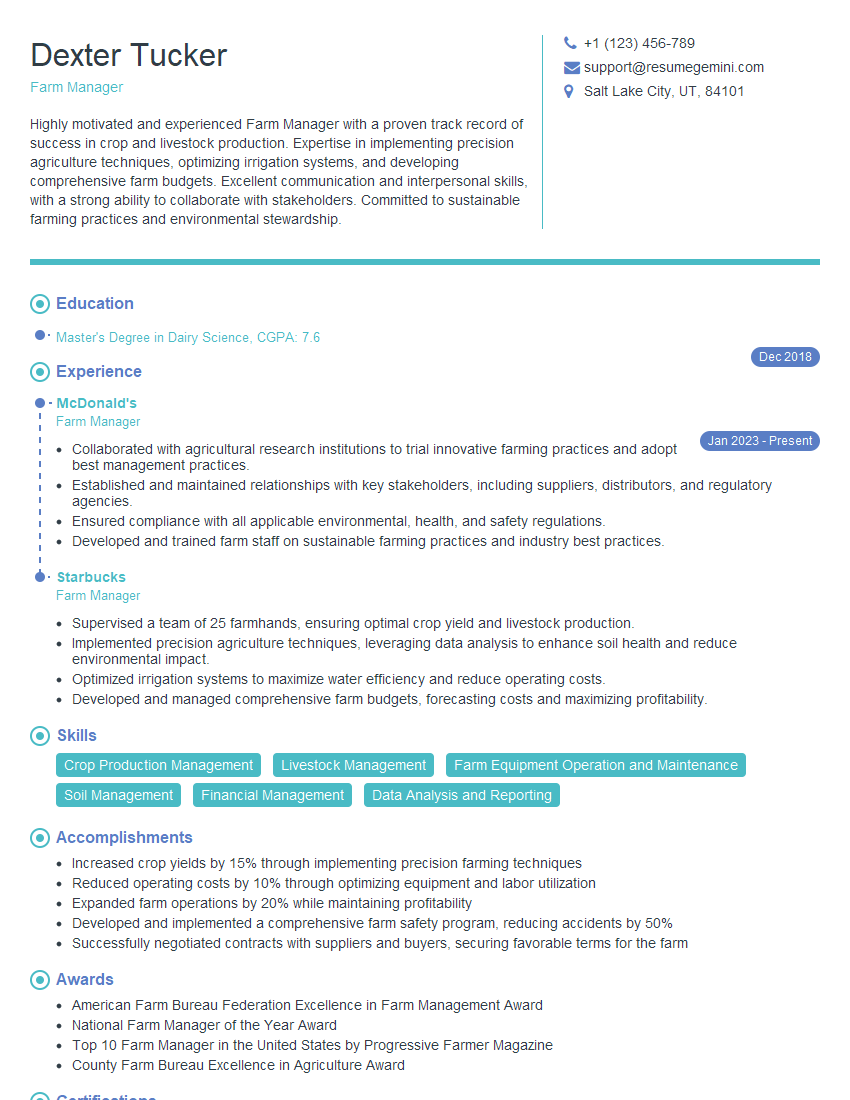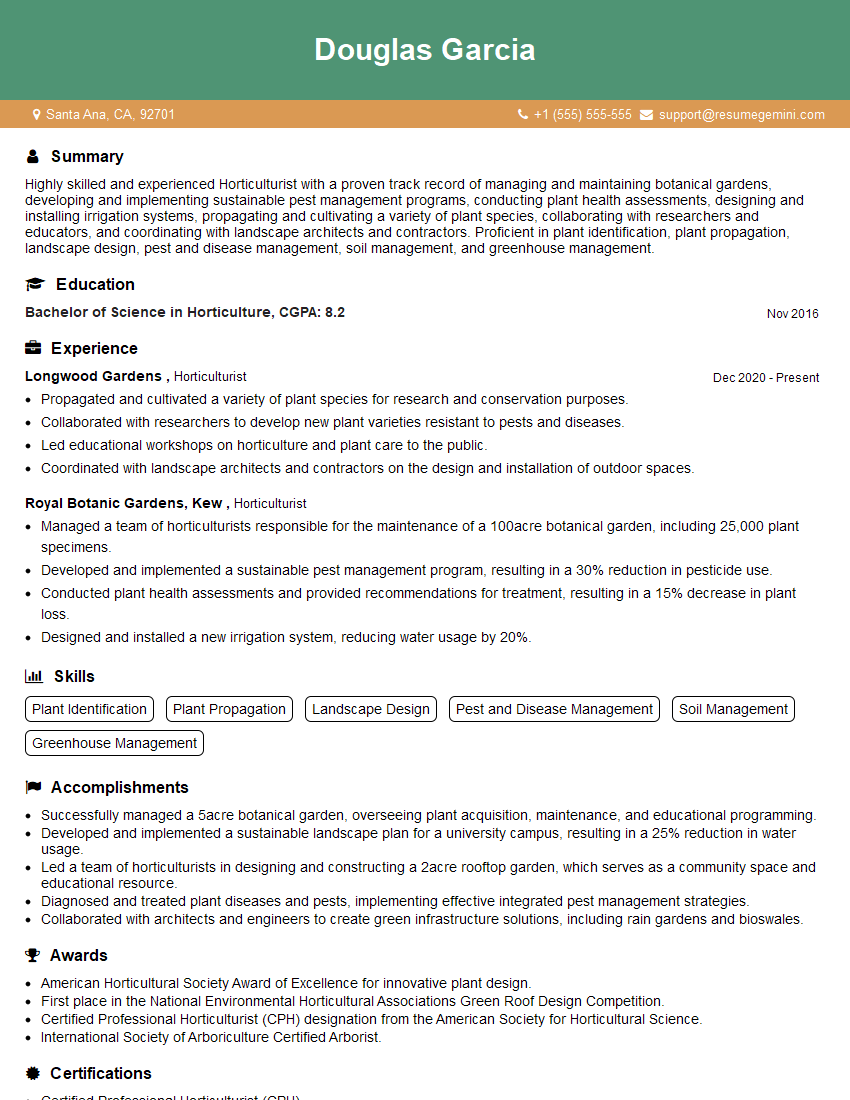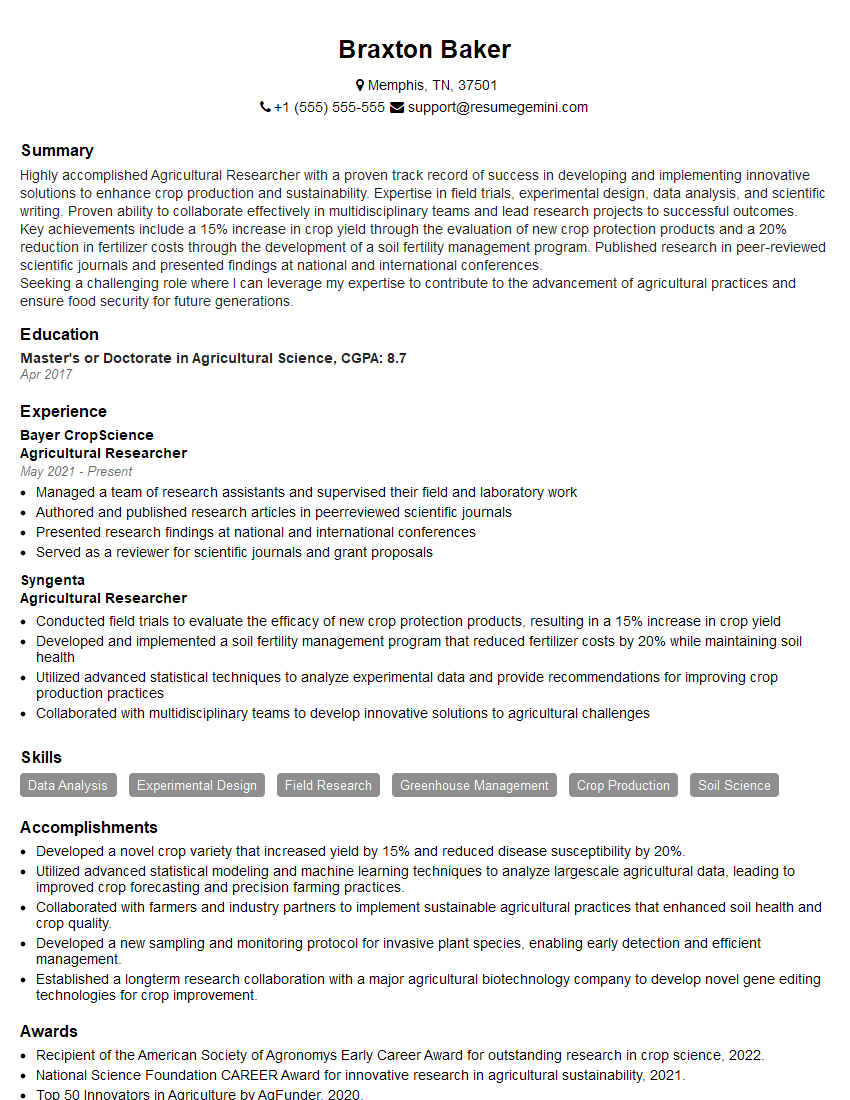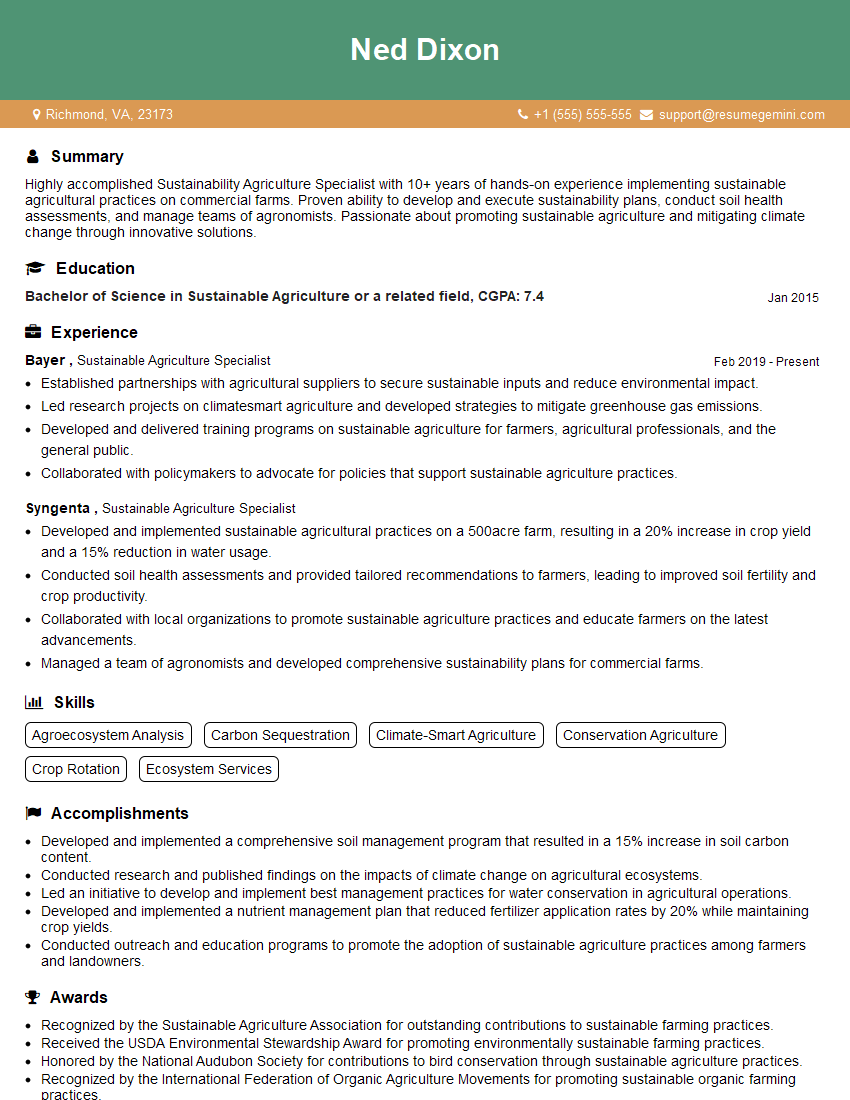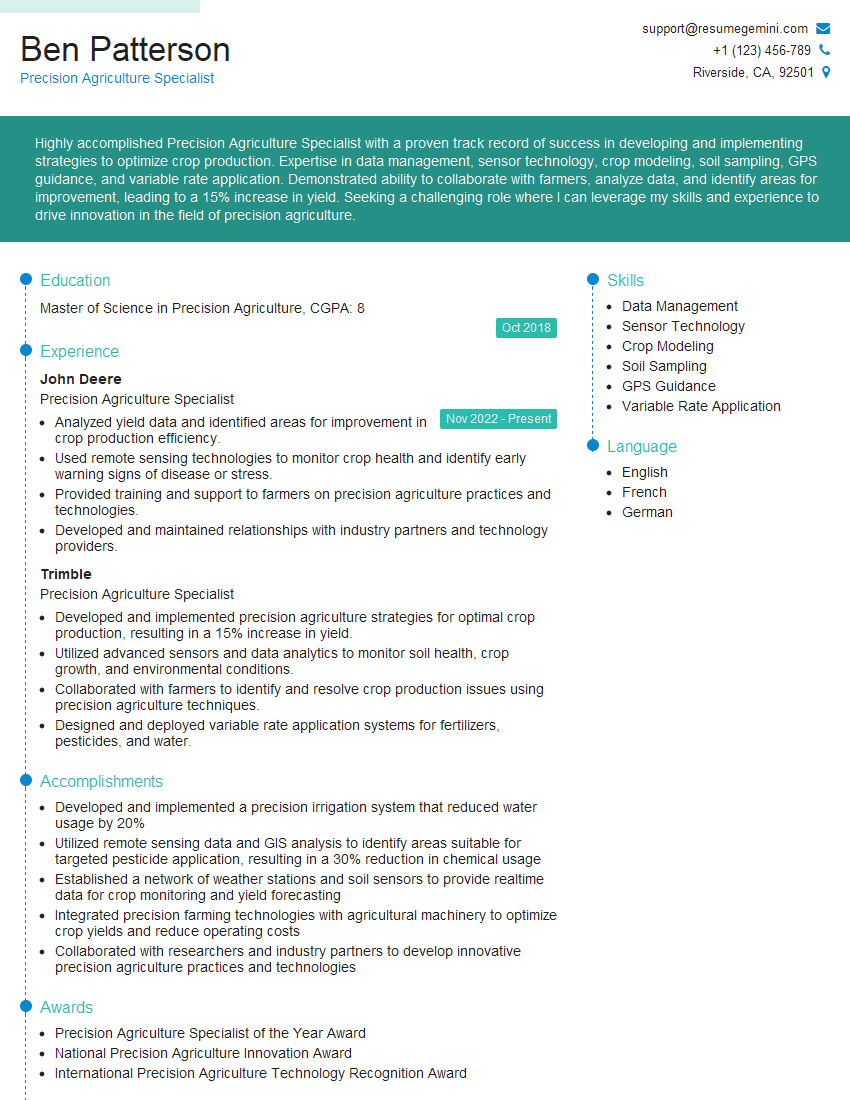The right preparation can turn an interview into an opportunity to showcase your expertise. This guide to Weed and Crop Identification interview questions is your ultimate resource, providing key insights and tips to help you ace your responses and stand out as a top candidate.
Questions Asked in Weed and Crop Identification Interview
Q 1. Describe the life cycle of a common weed in your region.
Let’s take the common weed, Amaranthus retroflexus (redroot pigweed), as an example. Its life cycle is a classic example of an annual weed. It begins with a seed, dormant in the soil perhaps for several years, germinating when soil temperatures and moisture are favorable, usually in spring. The seedling emerges, developing a taproot and cotyledons (seed leaves).
Then, the plant enters the vegetative stage, rapidly producing leaves and branches. This stage is characterized by vigorous growth, competing with crops for resources. Once it matures, it enters the reproductive phase, flowering and producing thousands of tiny seeds. These seeds are easily dispersed by wind, water, and even agricultural machinery. Finally, the plant dies, leaving behind a significant seed bank to begin the cycle anew.
Understanding this life cycle is crucial for effective weed management. Targeting specific stages, like germination or early vegetative growth, with herbicides or cultivation is much more effective than trying to control mature, seed-producing plants.
Q 2. Differentiate between monocotyledonous and dicotyledonous weeds.
The distinction between monocotyledonous (monocots) and dicotyledonous (dicots) weeds is fundamental in weed science. It lies primarily in the number of cotyledons (embryonic leaves) present in the seed. Monocots have one cotyledon, while dicots have two. This seemingly small difference leads to significant variations in morphology and physiology.
- Monocots: Often have parallel leaf venation (like grass blades), fibrous root systems, and flower parts in multiples of three. Examples include grasses (Poa annua, Lolium spp.) and sedges (Cyperus spp.).
- Dicots: Typically have reticulate (net-like) leaf venation, a taproot system, and flower parts in multiples of four or five. Examples include broadleaf weeds such as pigweed (Amaranthus spp.), dandelions (Taraxacum officinale), and bindweed (Convolvulus arvensis).
Understanding this distinction is vital for herbicide selection. Many herbicides are designed to be specific to either monocots or dicots, capitalizing on their physiological differences.
Q 3. Explain the principles of herbicide selectivity.
Herbicide selectivity refers to the ability of a herbicide to kill or inhibit the growth of certain plant species while leaving others relatively unharmed. This is based on several factors: differential herbicide uptake, differing metabolic pathways, and variations in herbicide target sites within the plant.
For example, some herbicides are absorbed more readily by dicots than monocots, due to differences in leaf cuticle structure. Others target specific enzymes or pathways involved in plant growth and development, which might be absent or differ significantly between target and non-target species. A classic example is the use of 2,4-D, which effectively controls broadleaf weeds while being relatively safe for most grasses.
Achieving selectivity is crucial in agriculture to protect the desired crop. Without selectivity, weed control would necessitate the use of broad-spectrum herbicides, which could severely damage or kill the crop along with the weeds.
Q 4. How do you identify herbicide resistance in weeds?
Herbicide resistance develops when a weed population evolves the ability to survive herbicide applications that would normally kill or inhibit its growth. Identification involves a combination of field observations and laboratory testing.
Field Observations: Look for patches of weeds surviving in areas where the herbicide has been effectively controlling them in previous years. Note the weed species and the specific herbicide used.
Laboratory Testing: Involves controlled experiments where weed samples are exposed to different herbicide concentrations. The response of the resistant population is compared to a susceptible population. This helps determine the level of resistance and the specific mechanism involved (e.g., target-site resistance, metabolic resistance). Often, genetic analysis is also used to confirm resistance.
Early detection and proper management strategies are key in preventing the spread of herbicide resistance. These strategies include using herbicide rotation, tank mixing different herbicides with different modes of action, and integrating cultural and biological control methods.
Q 5. What are the key morphological characteristics used to identify common crops?
Crop identification relies heavily on morphological characteristics, which are the observable physical features of the plant. Key characteristics include:
- Leaf shape and arrangement: Consider the leaf blade shape (linear, ovate, lanceolate), leaf margin (smooth, serrated, lobed), leaf venation (parallel, reticulate), and leaf arrangement (alternate, opposite, whorled).
- Stem characteristics: Observe stem type (erect, prostrate, climbing), branching pattern, hairiness (pubescence), and stem color.
- Flower and inflorescence structure: Note the flower color, shape, size, and arrangement on the plant (e.g., raceme, panicle, head).
- Fruit and seed characteristics: Observe fruit type (berry, legume, capsule), seed shape, size, and color.
Combining these characteristics allows for accurate identification. Field guides, online databases, and expert consultation can aid in this process. Proper identification is critical for disease and pest management as well as for selecting appropriate crop management techniques.
Q 6. Name three methods for controlling weeds in a no-till farming system.
No-till farming aims to minimize soil disturbance, leading to many benefits, but it can create challenges in weed management. Effective weed control in no-till systems often relies on integrated approaches:
- Herbicide application: Pre-emergent herbicides applied before planting prevent weed germination. Post-emergent herbicides can control existing weeds, targeting specific life stages.
- Cover crops: Planting cover crops during fallow periods can suppress weed growth through competition for resources and by physically smothering weeds. Cover crops can improve soil health too.
- Crop rotation: Strategically rotating crops can disrupt the weed seed bank and reduce weed pressure by favoring crops that outcompete particular weeds.
These methods are often combined to achieve optimal weed control while maintaining soil health and reducing environmental impact.
Q 7. Discuss the impact of different tillage practices on weed populations.
Tillage practices significantly influence weed populations. Different tillage methods have different effects on seed germination, seedling establishment, and overall weed pressure.
- Conventional tillage: Involves extensive soil disturbance, which can initially reduce weed numbers by burying seeds or destroying existing plants. However, repeated tillage often leads to increased weed emergence because it brings dormant seeds to the surface, exposes them to light, and stimulates germination. It can also select for weeds that thrive in disturbed conditions.
- Reduced tillage: Minimizes soil disturbance, leaving more crop residue on the soil surface. This reduces weed seed germination (due to shading and competition from residue) and also provides habitat for beneficial organisms which help control weeds.
- No-till: Completely avoids soil disturbance, relying heavily on other weed control methods (herbicides, cover crops, crop competition). While it can initially lead to higher weed pressure, this is temporary as long-term benefits outweigh the initial drawbacks.
The choice of tillage system significantly affects weed management strategy. A no-till system requires careful herbicide selection and integrated pest management strategies, whereas conventional tillage often necessitates more frequent and intensive tillage operations, impacting soil health and increasing operating costs.
Q 8. How can remote sensing be used for crop and weed identification?
Remote sensing utilizes sensors mounted on satellites, aircraft, or drones to capture electromagnetic radiation reflected or emitted from the Earth’s surface. This data is then processed to identify crops and weeds based on their unique spectral signatures. Different plants absorb and reflect light at different wavelengths. For example, healthy green vegetation strongly reflects near-infrared light, a characteristic used to differentiate it from bare soil or weeds. Multispectral and hyperspectral imaging techniques provide detailed spectral information, allowing for precise identification and mapping of various crop and weed species. This is particularly useful for large-scale field monitoring and precision agriculture applications. We can even use algorithms and machine learning techniques to analyze this spectral data and automate the identification process, leading to more efficient weed management strategies.
For instance, a farmer could use drone imagery to identify areas with heavy weed infestation within a soybean field. This targeted information allows for precision herbicide application, minimizing chemical use and protecting the environment. This technology is especially beneficial in diverse fields with multiple plant species where visual identification might be challenging or time-consuming.
Q 9. Explain the concept of Integrated Pest Management (IPM) and its application to weed control.
Integrated Pest Management (IPM) is a holistic approach to pest control that emphasizes minimizing the use of pesticides while maximizing effective pest management. Instead of relying solely on chemical controls, IPM integrates various strategies to prevent and suppress pests, including weeds. These strategies include:
- Monitoring: Regularly assessing the presence and severity of weed infestations.
- Cultural controls: Using practices like crop rotation, cover cropping, and appropriate tillage to suppress weeds.
- Biological controls: Introducing natural enemies of weeds, such as specific insects or pathogens.
- Mechanical controls: Employing methods such as hand weeding, hoeing, or mowing to remove weeds.
- Chemical controls: Using herbicides judiciously, only when necessary and after considering the other control methods.
For weed control, IPM starts with careful monitoring to identify the predominant weed species and their growth stages. Then, appropriate control methods are selected based on weed density, crop stage, and environmental conditions. For example, a farmer might implement cover cropping to suppress weeds before planting the main crop, followed by targeted herbicide application in patches with persistent weed growth. This approach minimizes pesticide use while ensuring effective weed management and minimizing the risk of herbicide resistance development.
Q 10. What are the environmental impacts of herbicide use?
Herbicide use, while effective in controlling weeds, can have significant environmental impacts. These include:
- Water contamination: Herbicides can leach into groundwater and surface water, contaminating drinking water sources and harming aquatic life.
- Soil degradation: Long-term herbicide use can disrupt soil microbial communities, impacting soil health and nutrient cycling.
- Air pollution: Some herbicides can volatilize and contribute to air pollution.
- Impact on non-target organisms: Herbicides can harm beneficial insects, pollinators, and other non-target organisms, disrupting ecological balance.
- Development of herbicide resistance: Overuse of the same herbicide can lead to the evolution of herbicide-resistant weed species, rendering the herbicide ineffective.
The environmental consequences can be severe, leading to decreased biodiversity, reduced water quality, and compromised agricultural productivity in the long term. Therefore, responsible herbicide use, as integrated within an IPM framework, is crucial to minimizing these detrimental effects.
Q 11. Describe different types of crop damage caused by weeds.
Weeds cause various types of damage to crops, impacting both yield and quality. These include:
- Competition for resources: Weeds compete with crops for essential resources such as water, nutrients, and sunlight, reducing crop growth and yield.
- Allelopathy: Some weeds release chemicals that inhibit the growth of nearby plants, negatively impacting crop development.
- Physical interference: Weeds can physically interfere with crop growth, hindering harvesting and reducing crop quality.
- Harbor of pests and diseases: Weeds can serve as hosts for crop pests and diseases, further damaging crop health and productivity.
- Reduced crop quality: Weeds can contaminate harvested crops, decreasing their market value and causing economic losses.
The severity of damage depends on the weed species, their density, and the growth stage of the crop. For instance, a dense infestation of aggressive weeds in a young crop can significantly reduce its yield, whereas a low level of weed infestation in a mature crop might have a minimal impact.
Q 12. How do you assess the economic impact of weed infestation?
Assessing the economic impact of weed infestation requires considering both direct and indirect costs. Direct costs include:
- Reduced crop yield: The most significant direct cost, calculated by estimating the yield loss due to weed competition.
- Increased production costs: Costs associated with weed control measures like herbicides, labor for weeding, or specialized machinery.
- Crop quality reduction: Losses due to weed contamination affecting market value.
Indirect costs are often harder to quantify but equally important and can include:
- Reduced market value: Lower prices received for contaminated or lower-quality crops.
- Increased harvesting costs: Difficulties in harvesting crops due to weed interference.
- Loss of market access: Inability to sell crops due to contamination or failing to meet quality standards.
Economic impact assessment usually involves a combination of field surveys, yield data analysis, and cost accounting to determine the overall financial losses caused by weed infestations. This information is crucial for making informed decisions on weed management strategies and allocating resources effectively.
Q 13. What is the role of cover crops in weed management?
Cover crops are plants grown primarily to improve soil health and protect it from erosion, but they also play a significant role in weed management. They function as a living mulch, shading the soil and reducing weed germination and growth. Their dense root systems compete with weeds for nutrients and water, suppressing weed emergence. Some cover crops, like certain legumes, can also fix atmospheric nitrogen, enhancing soil fertility and reducing the need for nitrogen fertilizers, which can inadvertently promote weed growth.
Examples of effective cover crops include winter rye, clover, and vetch. Choosing the appropriate cover crop species depends on the climate, soil type, and target weed species. A farmer might use a fast-growing cover crop like rye to quickly suppress weeds before planting the main crop. Then, incorporating the cover crop into the soil adds organic matter, improving soil structure and nutrient retention. This helps reduce the reliance on chemical weed control, making it a sustainable and environmentally friendly approach to weed management.
Q 14. Explain the principles of biological weed control.
Biological weed control involves using living organisms to suppress weed populations. This approach utilizes the natural enemies of weeds, such as:
- Insects: Specific insects that feed on particular weed species, effectively reducing their density.
- Pathogens: Fungi, bacteria, or viruses that infect and kill weeds.
- Vertebrates: Animals like grazing animals or fish that can consume weeds.
The success of biological control depends on careful selection of the appropriate biological agent and understanding its ecological interactions within the target environment. It is essential to ensure that the introduced organism doesn’t become invasive or harm non-target species. A thorough risk assessment and rigorous testing are vital before implementing any biological control program. Biological control often provides a long-term, sustainable solution to weed management by maintaining a balance within the ecosystem, although it may not offer immediate control, hence usually a supplementary method.
For example, the introduction of a specific weevil species has been successful in controlling the spread of certain invasive weeds in some regions.
Q 15. What are the advantages and disadvantages of different herbicide application methods?
Herbicide application methods vary widely, each with its own set of advantages and disadvantages. The choice depends on factors like weed type, crop type, terrain, budget, and environmental regulations.
- Pre-emergence application: Herbicides are applied before weed seeds germinate. Advantages: Prevents weed emergence, can be combined with other soil management practices. Disadvantages: Requires precise timing, less effective against existing weeds, may not be effective against all weed species. Example: Applying a pre-emergent herbicide to a soybean field before planting to control early-season weeds like pigweed.
- Post-emergence application: Herbicides are applied after weed emergence. Advantages: Targets specific weeds, can handle weed infestations that appear after planting. Disadvantages: Requires careful timing to maximize efficacy and minimize crop damage, can be more expensive, may require multiple applications.
- Foliar application: Herbicides are sprayed directly onto the leaves of weeds. Advantages: Quick acting, effective on a wide range of weeds. Disadvantages: Sensitive to weather conditions (wind, rain), can drift onto non-target plants, requires careful calibration to avoid crop damage. Example: Spot spraying herbicide on individual weeds in a cornfield.
- Soil application: Herbicides are incorporated into the soil. Advantages: Provides longer-lasting control, less susceptible to environmental conditions. Disadvantages: Less flexibility in targeting specific weeds, potential soil contamination if not managed properly.
Ultimately, a successful herbicide program often involves a combination of methods tailored to the specific situation.
Career Expert Tips:
- Ace those interviews! Prepare effectively by reviewing the Top 50 Most Common Interview Questions on ResumeGemini.
- Navigate your job search with confidence! Explore a wide range of Career Tips on ResumeGemini. Learn about common challenges and recommendations to overcome them.
- Craft the perfect resume! Master the Art of Resume Writing with ResumeGemini’s guide. Showcase your unique qualifications and achievements effectively.
- Don’t miss out on holiday savings! Build your dream resume with ResumeGemini’s ATS optimized templates.
Q 16. How do you interpret results from a weed survey?
Interpreting weed survey results involves a systematic approach. It’s not just about identifying the weeds present, but understanding their distribution, abundance, and the implications for crop production.
- Species Identification: Accurate identification of each weed species is paramount. This often requires expertise in plant taxonomy and morphology, sometimes supplemented with laboratory analysis.
- Abundance Assessment: This involves quantifying the weed density (number of weeds per unit area). Common methods include visual estimates, quadrat sampling, or digital image analysis.
- Distribution Mapping: The spatial distribution of weeds provides valuable information about their spread and potential impact. This can be visualized using maps, GIS software, or simple sketches.
- Weed Pressure Assessment: This combines information on species, abundance, and distribution to determine the overall weed pressure on the crop. High weed pressure can significantly reduce yield and quality.
- Recommendations: Based on the assessment, we can formulate specific management recommendations, including choice of herbicides, cultural control measures (tillage, crop rotation), and integrated pest management strategies.
For example, a survey showing a high density of a glyphosate-resistant weed like Palmer amaranth requires different management strategies than one with low density of a susceptible species.
Q 17. Describe your experience with GPS and GIS technologies in field mapping.
GPS and GIS technologies are indispensable tools for efficient and accurate field mapping. My experience encompasses using handheld GPS units to pinpoint weed infestations and using GIS software to create detailed maps for weed management strategies.
- Field Data Collection: I use GPS receivers to record the location of weed patches, soil samples, and other relevant field data.
- Data Integration: I import the collected data into GIS software (e.g., ArcGIS, QGIS) to create thematic maps showing the distribution of different weed species, soil properties, and other relevant factors.
- Spatial Analysis: GIS allows for spatial analysis, such as calculating weed density, identifying weed hotspots, and optimizing herbicide application routes.
- Report Generation: GIS facilitates the generation of professional-looking reports and maps, crucial for communicating findings to stakeholders and informing decision-making.
In a recent project, we used GIS to map the spread of a particularly aggressive weed in a large-scale agricultural operation. This map helped optimize herbicide application, reducing costs and improving efficacy compared to previous broad-spectrum applications.
Q 18. How do you handle conflicting identification results between visual observation and laboratory testing?
Conflicting identification results between visual observation and laboratory testing require a careful and methodical approach.
- Review Initial Observations: First, I revisit the initial visual observations, paying close attention to details like leaf shape, stem morphology, and flowering characteristics. I check for potential errors in initial identification.
- Examine Lab Results: I thoroughly review the lab results, ensuring that the sample was correctly handled and analyzed. Laboratory techniques such as DNA barcoding or morphological analysis may provide more definitive results.
- Consult Reference Materials: I consult relevant botanical keys, field guides, and online databases to compare the conflicting findings with the characteristics of known species.
- Seek Expert Opinion: If the discrepancy persists, I may consult with other experts in weed identification or send additional samples to a different laboratory for confirmation.
- Document Discrepancies: Regardless of the resolution, all conflicting findings and resolutions are carefully documented for future reference and quality control.
It’s crucial to remember that visual identification can be challenging, particularly with immature plants or species with similar characteristics. Laboratory testing provides a more objective confirmation, resolving ambiguities and improving the accuracy of weed management strategies.
Q 19. What are some common weed species in [Specific Region] and their control methods?
Please specify the region. The common weed species and their control methods vary significantly depending on geographic location, climate, and agricultural practices.
Example for a hypothetical ‘Central Plains’ region:
- Common Ragweed (Ambrosia artemisiifolia): A prolific annual weed that competes strongly with crops. Control methods include pre-emergent herbicides, tillage, and crop rotation.
- Giant Ragweed (Ambrosia trifida): Another aggressive annual. Similar control methods to common ragweed, but often requires stronger herbicide applications due to its larger size.
- Johnsongrass (Sorghum halepense): A perennial weed that can be very difficult to control. Strategies include herbicides specific to perennial grasses, repeated tillage, and cover cropping.
Effective weed management requires considering the specific weed species, their life cycle, and the environmental conditions.
Q 20. Explain the importance of accurate crop identification for harvest planning.
Accurate crop identification is crucial for effective harvest planning. Mistakes can lead to significant economic losses.
- Harvest Timing: Different crops reach maturity at different times. Accurate identification ensures that harvesting occurs at the optimal time, maximizing yield and quality.
- Equipment Selection: Appropriate harvesting equipment is crucial. For example, a combine harvester needs to be configured differently for harvesting wheat than for soybeans. Incorrect identification could lead to using the wrong equipment, causing damage or inefficient harvesting.
- Post-harvest Handling: The post-harvest handling of crops (drying, storage, processing) also depends on the crop type. Incorrect identification may lead to improper storage, resulting in spoilage and loss.
- Yield Estimation: Accurate crop identification allows for better yield estimation. This information is critical for market planning, pricing, and resource allocation.
For example, misidentifying a variety of wheat could lead to harvesting too early or too late, resulting in significant yield loss. Or, misidentifying a type of soybean could result in damage during the harvest due to incorrect combine settings.
Q 21. How can soil testing help inform weed management strategies?
Soil testing provides valuable information that can significantly improve weed management strategies.
- Nutrient Levels: Soil nutrient levels affect weed growth. Low nutrient levels can hinder crop growth, making them more susceptible to weed competition. Soil testing can identify nutrient deficiencies and allow for appropriate fertilization to enhance crop vigor and competitiveness.
- Soil pH: Soil pH influences the efficacy of certain herbicides. Knowing the pH helps in selecting herbicides that are most effective under specific soil conditions.
- Soil Texture: Soil texture influences water availability and herbicide movement in the soil. This information is crucial for determining appropriate herbicide application methods and rates.
- Organic Matter Content: High organic matter content can improve soil health and reduce weed pressure naturally. Soil testing provides information on organic matter levels, allowing for informed management decisions regarding soil amendments.
By integrating soil test results into weed management plans, we can optimize herbicide use, reduce costs, and improve overall crop yields. For example, if soil testing reveals low phosphorus levels, addressing this deficiency will improve crop health and competitiveness against weeds, thereby minimizing the need for herbicides.
Q 22. What are the benefits of using precision agriculture technologies for weed control?
Precision agriculture technologies offer significant advantages in weed control by enabling targeted applications of herbicides and other weed management strategies. Instead of blanket spraying an entire field, these technologies allow for site-specific treatments, minimizing herbicide use and maximizing efficiency.
- Reduced herbicide use: By identifying and treating only weed-infested areas, we significantly reduce the amount of herbicide needed, lowering costs and environmental impact. Imagine treating only the patches of weeds in a field of corn instead of spraying the entire field – that’s a massive difference!
- Improved weed control: Targeted application ensures higher herbicide concentrations reach the weeds, enhancing efficacy. This is particularly important for herbicide-resistant weeds, where precision is crucial.
- Environmental benefits: Reduced herbicide use contributes to cleaner water, healthier soil, and biodiversity preservation. This approach is crucial for sustainable agricultural practices.
- Cost savings: Less herbicide translates directly to lower input costs for farmers. Furthermore, the efficient application saves time and labor.
- Data-driven decisions: Technologies like GPS, sensors, and drones collect detailed data on weed distribution and crop health, facilitating better decision-making in weed management.
For example, using a robot equipped with computer vision to identify and spot-spray individual weeds significantly reduces herbicide use compared to traditional broadcast spraying. Similarly, using spectral imaging to identify weed stress can help optimize herbicide application timing.
Q 23. Describe your experience with weed scouting and data recording.
My experience in weed scouting and data recording spans over ten years, encompassing various agricultural settings and crops. I’m proficient in both manual and technological approaches. Manual scouting involves physically walking through fields, visually assessing weed pressure, identifying weed species, and estimating their density. I use standardized scales to quantify weed density, such as plants per square meter or percentage ground cover. My data is meticulously recorded in field notebooks or dedicated apps, including GPS coordinates to pinpoint weed infestations.
For example, I’ve documented weed pressure in soybean fields, noting the prevalence of Palmer amaranth, waterhemp, and giant ragweed, as well as their locations within each field. I’ve also utilized digital tools like precision agriculture platforms to record this data, integrating it with imagery from drones or satellites for a comprehensive view of weed distribution and crop health. This allows for creating maps that illustrate weed pressure across the entire field, which guides targeted weed control strategies.
Technological integration is key. I’m proficient in using various data management software to analyze my findings, generate reports, and create insightful visualizations for improved decision-making. This data is invaluable for optimizing herbicide application timing and rates for maximum efficacy and minimizing environmental impact.
Q 24. Explain the concept of herbicide drift and its mitigation strategies.
Herbicide drift is the unintentional movement of herbicide spray from its target area to non-target areas, causing damage to nearby crops, sensitive vegetation, or even impacting human health. This can occur through wind, air currents, temperature inversions, or improper spray application. Think of it like a painter accidentally spraying paint outside the designated area.
- Minimizing drift: Utilizing low-drift nozzles designed to reduce particle size and spray velocity, choosing appropriate application timing (avoiding windy conditions), and using appropriate buffer zones around sensitive areas are crucial.
- Proper equipment calibration and maintenance: Ensuring spray equipment is properly calibrated and maintained minimizes the potential for excessive spraying and potential drift. This also reduces waste and increases efficiency.
- Weather monitoring: Checking weather forecasts before spraying and delaying applications during windy or high-temperature conditions is essential. This is a critical preventative measure.
- Training and education: Properly training applicators on best practices for herbicide application is vital in preventing drift. This involves understanding nozzle selection, spray pressure, and environmental factors.
For instance, a temperature inversion can trap herbicide spray close to the ground, leading to unexpected drift. Proper training helps identify and manage this phenomenon by delaying applications during such events. Furthermore, establishing appropriate buffer zones around water bodies and other sensitive habitats prevents contamination and protects the environment.
Q 25. How do you ensure compliance with pesticide regulations?
Compliance with pesticide regulations is paramount. I ensure compliance through several key practices:
- Licensing and certification: Maintaining up-to-date pesticide applicator licenses and certifications is essential and demonstrates commitment to safe and responsible pesticide use.
- Label reading and adherence: Always thoroughly reading and following the label instructions for each pesticide product. This includes understanding application rates, safety precautions, and required personal protective equipment.
- Record-keeping: Maintaining detailed records of pesticide applications, including the date, location, pesticide used, application rate, and weather conditions, is mandatory for audits and compliance verification. This is especially important for traceability and compliance tracking.
- Proper disposal: Following all guidelines and regulations for proper pesticide container disposal and managing leftover product. Improper disposal can harm the environment and public health.
- Staying informed: Keeping abreast of any changes or updates in pesticide regulations through professional organizations, government websites, and training programs is crucial.
For example, I regularly check the Environmental Protection Agency (EPA) website for updates on pesticide registrations and restrictions. Maintaining accurate records allows quick retrieval of necessary information during inspections or audits, ensuring compliance and preventing penalties.
Q 26. How do you stay up-to-date with advancements in weed science and crop identification?
Staying current in weed science and crop identification demands continuous learning. I employ several strategies:
- Professional organizations: Active membership in organizations such as the Weed Science Society of America (WSSA) provides access to publications, conferences, and networking opportunities with leading experts.
- Scientific journals and publications: Regularly reviewing peer-reviewed journals and industry publications on weed science and crop identification keeps me informed of the latest research and advancements.
- Conferences and workshops: Attending conferences and workshops offers valuable opportunities for learning about new technologies, techniques, and research findings directly from experts in the field.
- Online resources and databases: Utilizing online databases and resources for plant identification, such as university extension websites and online image libraries, allows quick and efficient identification of unknown plants.
- Continuing education: Pursuing continuing education courses and workshops on integrated pest management (IPM) and precision agriculture enhances my knowledge and skills in weed management.
For example, attending the annual WSSA meeting provides insights into the latest research on herbicide resistance and new weed control strategies. Regularly checking the publications from my state’s agricultural extension service keeps me updated on local weed issues and best management practices.
Q 27. Describe a time you had to overcome a challenge related to weed identification or control.
I once encountered a challenging situation involving the misidentification of a particularly aggressive weed in a large-scale organic vegetable production system. Initially, the weed was mistaken for a harmless species due to its early growth stage. This led to a delay in implementing appropriate control measures, resulting in a significant infestation within weeks.
To overcome this challenge, I first implemented a more rigorous weed identification protocol, which involved collecting samples and consulting with university specialists. Microscopic examination and DNA barcoding were used to confirm the species. Once correctly identified, we collaborated with the farm manager to develop a comprehensive integrated pest management (IPM) strategy, using a combination of mechanical weeding, targeted hand-pulling, and biological control agents.
This experience highlighted the critical need for thorough and accurate weed identification, emphasizing the importance of utilizing multiple identification methods and collaborating with specialists for confirmation when uncertainty arises. It also reinforced the importance of proactive weed management and early intervention to prevent significant infestations and minimize economic losses.
Q 28. What are your preferred resources for identifying unknown plants?
My preferred resources for identifying unknown plants leverage both digital and physical resources, combining strengths for reliable identification:
- University extension websites: These websites provide detailed plant information, often including images and diagnostic keys, specific to the region or state.
- Online plant identification apps: Several user-friendly apps utilize image recognition to suggest potential species, often incorporating regional databases for greater accuracy. These are a great starting point.
- Field guides and plant identification manuals: These books contain detailed descriptions, illustrations, and keys to assist in plant identification, incorporating detailed morphological characteristics.
- Herbarium collections: Access to herbarium specimens offers detailed examination of plant structures, useful when dealing with complex or ambiguous characteristics. This is particularly valuable for rare or unusual species.
- Expert consultation: Consulting with plant taxonomists or weed scientists provides expert advice and confirmation for difficult identification challenges, particularly for nuanced species differentiation.
For example, when facing a particularly challenging identification, I often use a combination of an online plant identification app and a regional field guide, followed by verification with a plant expert if necessary. This layered approach helps ensure accurate identification and avoids costly mistakes in weed management strategies.
Key Topics to Learn for Weed and Crop Identification Interview
- Morphological Characteristics: Learn to identify key distinguishing features of various weeds and crops, including leaf shape, stem structure, flowering patterns, and root systems. Understand how these features vary across different growth stages.
- Physiological Differences: Explore the differences in growth habits, nutrient requirements, and responses to environmental factors between weeds and crops. This includes understanding the competitive interactions between them.
- Ecological Considerations: Understand the impact of different weed species on crop yields and the influence of environmental conditions on weed and crop growth. This includes knowledge of weed dispersal mechanisms and preferred habitats.
- Identification Techniques: Practice using various identification tools such as dichotomous keys, field guides, and online resources. Develop a systematic approach to identifying unknown plants.
- Pest and Disease Management: Understand how accurate identification contributes to effective pest and disease management strategies, specifically targeting weeds while protecting crops.
- Herbicide Application and Efficacy: Learn about different herbicide types, application methods, and their impact on weed control and crop safety. Understand factors affecting herbicide effectiveness.
- Sustainable Weed Management Practices: Explore integrated pest management (IPM) strategies and environmentally friendly weed control techniques, focusing on minimizing herbicide use and promoting biodiversity.
- Legal and Regulatory Aspects: Familiarize yourself with relevant regulations and legislation related to weed control and crop production in your region.
Next Steps
Mastering weed and crop identification is crucial for career advancement in agriculture, horticulture, and related fields. Accurate identification is the foundation of effective crop management, ensuring high yields and sustainable practices. To stand out to potential employers, creating an ATS-friendly resume is vital. ResumeGemini offers a powerful tool to build a professional and effective resume that highlights your skills and experience. ResumeGemini provides examples of resumes tailored to Weed and Crop Identification to help guide your process, ensuring your application gets noticed.
Explore more articles
Users Rating of Our Blogs
Share Your Experience
We value your feedback! Please rate our content and share your thoughts (optional).
What Readers Say About Our Blog
This was kind of a unique content I found around the specialized skills. Very helpful questions and good detailed answers.
Very Helpful blog, thank you Interviewgemini team.
